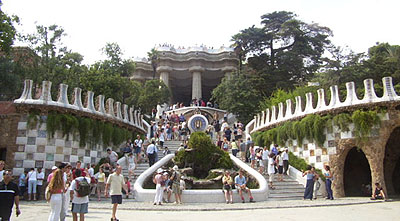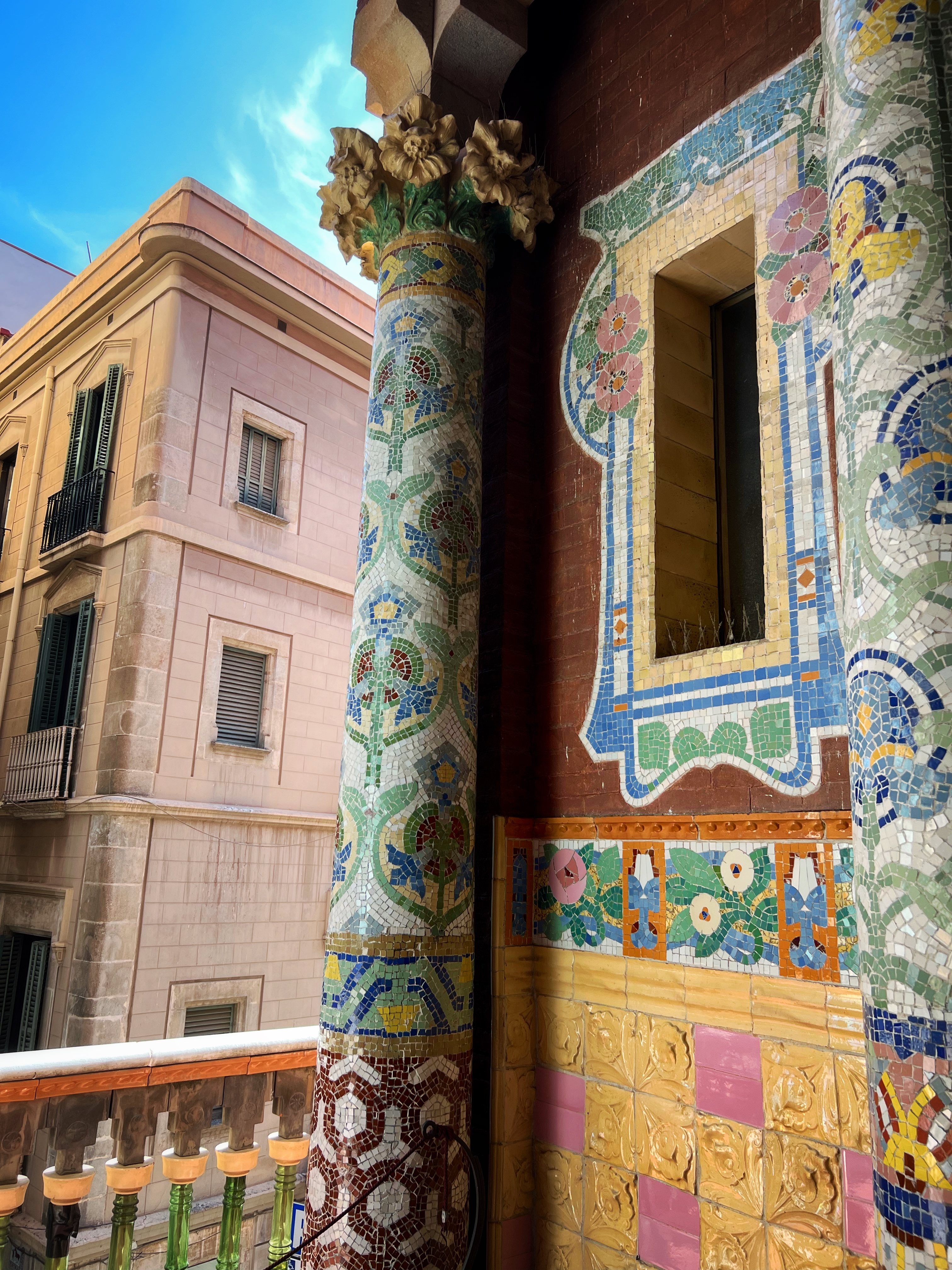|
Casa Lleó Morera
The Casa Lleó Morera () is a building designed by noted modernisme architect Lluís Domènech i Montaner, located at Passeig de Gràcia 35 in the Eixample district of Barcelona. In 1902 Francesca Morera assigned Lluís Domènech i Montaner to remodel ancient "casa Rocamora", built in 1864. She died in 1904, and the building was named after her son, Albert Lleó i Morera. The building is located on the corner of Carrer del Consell de Cent, and is one of the three important buildings of Barcelona's Illa de la Discòrdia ("Block of Discord"), and it is the only building of the block awarded Barcelona's town council's Arts Building Annual Award (Concurso anual de edificios artísticos), obtained in 1906. The building lost some of its most representative elements, such as the ''tempietto'' on its top (now restored) and the ground floor and mezzanine's architectural sculpture. The building is also known as the residence of Cuban-Catalan photographer Pau Audouard. The building The bu ... [...More Info...] [...Related Items...] OR: [Wikipedia] [Google] [Baidu] |
Modernisme
''Modernisme'' (, Catalan for "modernism"), also known as Catalan modernism and Catalan art nouveau, is the historiographic denomination given to an art and literature movement associated with the search of a new entitlement of Catalan culture, one of the most predominant cultures within Spain. Nowadays, it is considered a movement based on the cultural revindication of a ''Catalan identity''. Its main form of expression was ''Modernista'' architecture, but it also encompassed many other arts, such as painting and sculpture, and especially the design and the decorative arts (cabinetmaking, carpentry, forged iron, ceramic tiles, ceramics, glass-making, silver and goldsmith work, etc.), which were particularly important, especially in their role as support to architecture. Modernisme was also a literary movement (poetry, fiction, drama). Although Modernisme was part of a general trend that emerged in Europe around the turn of the 20th century, in Catalonia the trend acquired it ... [...More Info...] [...Related Items...] OR: [Wikipedia] [Google] [Baidu] |
Figueres
Figueres (, ; , es, Figueras, ) is the capital of the ''comarca'' of Alt Empordà, in the province of Girona, Catalonia, Spain. The town is the birthplace of artist Salvador Dalí, and houses the Teatre-Museu Gala Salvador Dalí, a large museum designed by Dalí himself which attracts many visitors. It is also the birthplace of Narcís Monturiol, inventor of the first successful machine-powered submarine. Also born here was Mónica Naranjo, one of the best selling Spanish singers of the 1990s and 2000s. History The town's name derives from that of ''Ficaris'', of Visigoth origin. In 1267, King James I of Aragon conceded it ''fuero'' rights, but four years later Count Ponç IV of Empúries set the town on fire. In 1794 Figueras was surrendered to France, but it was regained in 1795. During the Peninsular War it was taken by the French in 1808, recaptured by the Spaniards in 1811, and retaken by the French in the same year. During the Spanish Civil War, it remained loyal to t ... [...More Info...] [...Related Items...] OR: [Wikipedia] [Google] [Baidu] |
Salvador Dalí
Salvador Domingo Felipe Jacinto Dalí i Domènech, Marquess of Dalí of Púbol (; ; ; 11 May 190423 January 1989) was a Spanish Surrealism, surrealist artist renowned for his technical skill, precise draftsmanship, and the striking and bizarre images in his work. Born in Figueres, Catalonia, Spain, Dalí received his formal education in fine arts in Madrid. Influenced by Impressionism and the Renaissance art, Renaissance masters from a young age he became increasingly attracted to Cubism and avant-garde movements. He moved closer to Surrealism in the late 1920s and joined the Surrealist group in 1929, soon becoming one of its leading exponents. His best-known work, ''The Persistence of Memory'', was completed in August 1931, and is one of the most famous Surrealist paintings. Dalí lived in France throughout the Spanish Civil War (1936 to 1939) before leaving for the United States in 1940 where he achieved commercial success. He returned to Spain in 1948 where he announced his ... [...More Info...] [...Related Items...] OR: [Wikipedia] [Google] [Baidu] |
Francisco Ferrer Bartolomé
Francisco is the Spanish and Portuguese form of the masculine given name ''Franciscus''. Nicknames In Spanish, people with the name Francisco are sometimes nicknamed "Paco". San Francisco de Asís was known as ''Pater Comunitatis'' (father of the community) when he founded the Franciscan order, and "Paco" is a short form of ''Pater Comunitatis''. In areas of Spain where Basque is spoken, "Patxi" is the most common nickname; in the Catalan areas, "Cesc" (short for Francesc) is often used. In Spanish Latin America and in the Philippines, people with the name Francisco are frequently called "Pancho". " Kiko" is also used as a nickname, and "Chicho" is another possibility. In Portuguese, people named Francisco are commonly nicknamed " Chico" (''shíco''). This is also a less-common nickname for Francisco in Spanish. People with the given name * Pope Francis is rendered in the Spanish and Portuguese languages as Papa Francisco * Francisco Acebal (1866–1933), Spanish writer and ... [...More Info...] [...Related Items...] OR: [Wikipedia] [Google] [Baidu] |
Raimon Duran I Reynals
Ramon Pelegero Sanchis, who takes the stage name of Raimon (), is a Spanish singer. He performs in the musical style of Nova Cançó, and in the Catalan language. Biography Youth Raimon was born in Xàtiva in the province of Valencia, Spain on December 2, 1940, at ''el carrer Blanc'' (White Street), which he references in some songs. In his youth he worked for several years as a radio broadcaster in his hometown, absorbing the music of artists as diverse as Juliette Gréco, The Platters, and Juanito Valderrama. At age 21, he moved to Valencia in order to study history. It was there that he discovered Catalan culture, and read writers such as Ausiàs March, Salvador Espriu, Josep Pla, and Joan Fuster, among others. Prior to this, however, he had already written his first song, ''Al vent'' (To the wind). In 1962, Raimon made his first public appearance at a literary prize ceremony. A little later, after entering a contest in Castelló, where Els Setze Jutges participated, he s ... [...More Info...] [...Related Items...] OR: [Wikipedia] [Google] [Baidu] |
Noucentisme
Noucentisme in Catalonia (, ''noucentista'' being its adjective) was a Catalan cultural movement of the early 20th century that originated largely as a reaction against Modernisme, both in art and ideology, and was, simultaneously, a perception of art almost opposite to that of avantgardists. In 1906, Eugeni d'Ors coined the term following the Italian tradition of naming styles after the centuries (for example, ''Quattrocento'', '' Cinquecento'', etc.) and using the homonyms ''nou'' (nine) and ''nou'' (new) to suggest it was a renovation movement. The same year two essential works for Noucentisme were published: '' Els fruits saborosos'' by Josep Carner and "La nacionalitat catalana" by the Conservative politician Enric Prat de la Riba. In the arts Despite certain similarities between the movements, it opposed Modernisme, the previous movement, and the radical and individualist views and Bohemian lifestyle most of its proponents engaged in. Noucentisme glorified order and what t ... [...More Info...] [...Related Items...] OR: [Wikipedia] [Google] [Baidu] |
Palau De La Música Catalana
Palau de la Música Catalana (, en, Palace of Catalan Music) is a concert hall in Barcelona, Catalonia, Spain. Designed in the Catalan '' modernista'' style by the architect Lluís Domènech i Montaner, it was built between 1905 and 1908 for Orfeó Català, a choral society founded in 1891 that was a leading force in the Catalan cultural movement that came to be known as the ''Renaixença'' (Catalan Rebirth).Benton, Tim. ''Modernismo in Catalonia'' In: ''Art Nouveau Architecture'' (Frank Russell, editor), New York: Arch Cape Press, 1986. . It was inaugurated on 9 February 1908. The construction project was mainly financed by Orfeó Català, but important financial contributions also came from Barcelona's wealthy industrialists and bourgeoisie. The palace won the architect an award from the Barcelona City Council in 1909, given to the best building built during the previous year. Between 1982 and 1989, the building underwent extensive restoration, remodeling, and extension unde ... [...More Info...] [...Related Items...] OR: [Wikipedia] [Google] [Baidu] |
Photography
Photography is the art, application, and practice of creating durable images by recording light, either electronically by means of an image sensor, or chemically by means of a light-sensitive material such as photographic film. It is employed in many fields of science, manufacturing (e.g., photolithography), and business, as well as its more direct uses for art, film and video production, recreational purposes, hobby, and mass communication. Typically, a lens is used to focus the light reflected or emitted from objects into a real image on the light-sensitive surface inside a camera during a timed exposure. With an electronic image sensor, this produces an electrical charge at each pixel, which is electronically processed and stored in a digital image file for subsequent display or processing. The result with photographic emulsion is an invisible latent image, which is later chemically "developed" into a visible image, either negative or positive, depending on the purp ... [...More Info...] [...Related Items...] OR: [Wikipedia] [Google] [Baidu] |
Telephone
A telephone is a telecommunications device that permits two or more users to conduct a conversation when they are too far apart to be easily heard directly. A telephone converts sound, typically and most efficiently the human voice, into electronic signals that are transmitted via cables and other communication channels to another telephone which reproduces the sound to the receiving user. The term is derived from el, τῆλε (''tēle'', ''far'') and φωνή (''phōnē'', ''voice''), together meaning ''distant voice''. A common short form of the term is ''phone'', which came into use early in the telephone's history. In 1876, Alexander Graham Bell was the first to be granted a United States patent for a device that produced clearly intelligible replication of the human voice at a second device. This instrument was further developed by many others, and became rapidly indispensable in business, government, and in households. The essential elements of a telephone are a ... [...More Info...] [...Related Items...] OR: [Wikipedia] [Google] [Baidu] |


.jpg)



